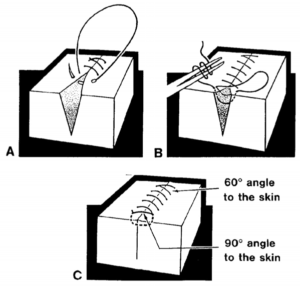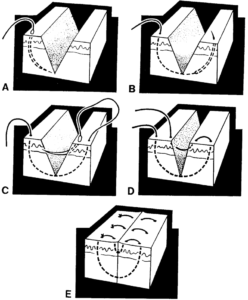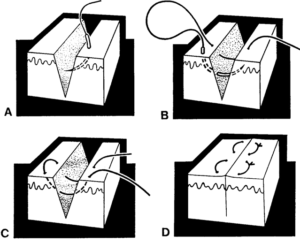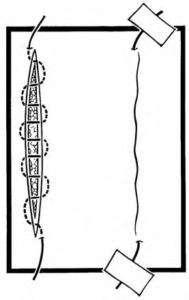a. Running Suture. A running suture (figure 2-9) is similar to the simple suture in technique. The difference is that the suturing material is not cut and tied with each succeeding stitch.
Multiple loops are made, starting at one end of the laceration and working toward the other end of the laceration. For the final loop, enter the skin just beside the entry point of the preceding stitch. After all the loops are in place, adjust the tension along the repair and tie the suture to itself.

(1) Advantages. Among the advantages of the running suture are that these sutures are inserted fast and are easy to remove. Also, the cosmetic appearance is comparable to that of interrupted sutures.
(2) Disadvantages. One of the disadvantages to the running suture is that a break anywhere along the suture can cause the entire suture line to unravel. Also, if a mistake is made, the suture must be cut, the loop removed, and the previous suture stitch must be knotted.
b. Locked Running Suture. The locked running suture (figure 2-10) is similar to the running suture. This suture, however, passes through the preceding loop before reentering the skin.
(1) Advantages. The locked running suture is useful in the rare situations where the wound edges have to be pulled together under tension to control bleeding. The sutures are secure in that they are locked into preceding loops.
(2) Disadvantages. Inserting the locked running sutures take more time. Also, tissue may be strangled if the sutures are not inserted carefully.

c. Vertical Mattress Suture. The vertical mattress suture (figure 2-11) involves placing a double line of suture material across the wound. The skin is entered and exited twice, instead of only once which is normal with simple sutures. The result is that two lines of suture lie one above the other.
(1) Technique. Begin as you would for a simple suture. Enter and exit the wound, however, a generous distance from the wound edge. Then, reenter the skin about one to two millimeters from the wound edge. Tie the suture normally.

(2) Advantages. The vertical mattress suture ensures wound edge eversion. This type of suture is useful in areas where the wound edges have a tendency to invert.
(3) Disadvantages. There are twice as many suture marks as with simple sutures. The reason is that most vertical mattress sutures require four points of skin entry and exit.
d. Horizontal Mattress Suture. In this type of suture (figure 2-12), the two lines of suture lie parallel to one another in a horizontal plane. The needle enters on the far side of the wound and exits on the near side. Then, the pattern is reversed; the needle enters on the near side of the wound and exits on the far side of the wound. The suture is tied normally.

(1) Advantages. The horizontal mattress suture everts the skin edges powerfully. A single horizontal mattress stitch can take the place of two simple ties, thus saving time. This suture is less likely to rip through the skin.
(2) Disadvantages. Puckering may occur if too much pressure is exerted. There is less control than with other types of sutures.
e. Subcuticular Suture. A subcuticular suture (figure 2-13) is essentially a running horizontal mattress stitch. This suture is placed just below the dermalepidermae junction. Enter the skin three to four millimeters from one end of the wound. Burrow through the deep tissue to emerge in the subcuticular plane at the apex of the wound. Then, pass the suture through the subcuticular tissue on alternate sides of the wound. The point of entry should be directly across from the exit of the previous stitch.
(1) Advantages. This type of stitch avoids suture marks and is best suited for straight lacerations. Using absorbable suture material is excellent in cases where the patient cannot be relied on to return for suture removal.
(2) Disadvantages. Subcuticular suturing is more difficult to learn. Also, this type of suturing takes time to perform.

